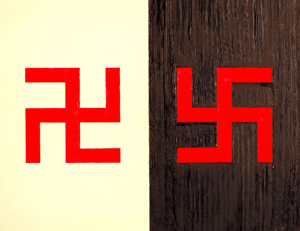 HIT : 5408
HIT : 5408
 HIT : 5408
HIT : 5408
TITLE: Opposites Attract
DATE: October 2011
PRICE: ¥ 3,120,000
PREFERRED BUYER: Museum of the Imperial Collections, Imperial Palace, Tokyo, Japan
CONDITIONS OF SALE: This painting has to be exhibited free of charge and continuously until Americans withdraw their military personal from Japan.
TECHNIQUE: Oil on canvas, unframed.
DIMENSIONS: 65 x 50 cm
STORY: In its 5,000 years of history, from the Indus Valley Civilization to Nazi Germany, swastika is a symbol with probably most opposing meanings in different parts of the modern world. Despite the stigma attached to it during its brief an unsuccessful usage in the Western World, swastika continues to be widely used in Indian religions, specifically in Hinduism and Buddhism. Its use is probably most prominent in Japan, where it is a symbol for temples and shrines, both on the streets and on the maps. Here it is always left-facing and on a white background, probably to make it distinctly different from the Nazi symbol. It is interesting how many Japanese like to point out to their friends that American tourists confuse the two symbols, and often protest against any use of swastika in public places. This, in the minds of Japanese people, is probably a form of quiet protest against American occupation, which is still extremely shameful. One wonders though if the Nazis invented the whole thing and used the swastika as a symbol of their "Aryan" race, just to win support of the Buddhist world. The archeological evidence suggests that swastika-looking decorations appeared probably independently many times during human history, but it remains to be seen if it will remain a symbol of good luck, as its Sanskrit translation suggests.